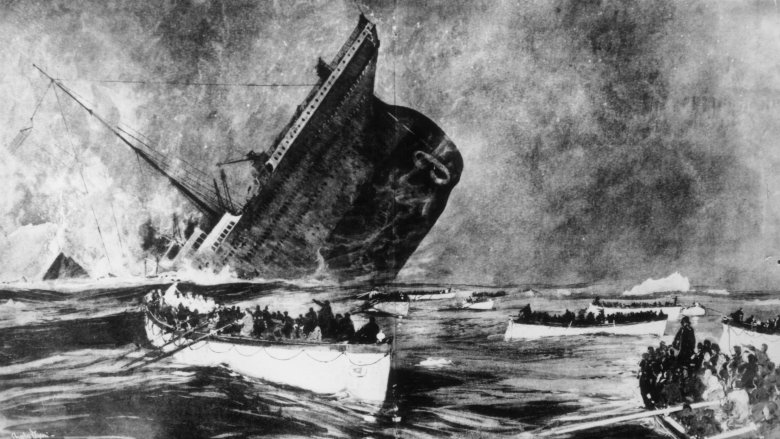History's Most Unlucky People
Think you've had a bad day? Well, it happens to the best of us. Maybe you're a little overworked, or you've had a fight with someone, or things simply haven't come together for you. We all have our ups and downs, and if you happen to currently be in the middle of a significant down, here's a bit of advice: just be thankful you're not these folks. History is awash with heroes and villains, but these unfortunate few have made their mark on time simply by being utterly and dreadfully unlucky. You might be having a hard day, but you've never been assaulted by a flying tortoise or caught in the blast radius of a nuclear weapon (twice). Think about that next time you miss your train.
Violet Jessop
Violet Jessop was born in 1887. According to Gizmodo, Jessop took a job as a stewardess with the White Star Line in 1908 after suffering a brief bout with tuberculosis. Two years later, she began working on the RMS Olympic and was aboard when the ship famously collided with the HMS Hawke in 1911. Neither ship sank, however, and Jessop made it back to port unharmed.
Quite finished with all the excitement of being caught up in a ship-to-ship collision, Jessop left shortly after and, persuaded by her friends and family, took a new job on the Olympic's sister ship, the RMS Titanic. You know how that one went. Jessop just managed to escape with her life and was rescued by the Carpathia along with the Titanic's other survivors.
In what many might regard as a spectacular lack of self-awareness, Jessop went on to work as a nurse on the Titanic's other sister ship, the Britannic, during World War I. Naturally, she was aboard when that ship hit a German mine and sank. She survived and, after (fairly sensibly) deciding to leave her employment at the White Star Line, went to join the Red Star Line instead. She worked aboard a number of cruises for several years afterward — empty cruises, one assumes.
Ann Hodges
You ever get the feeling that, some days, the universe just wants you dead? Well, you ought to meet Ann Hodges. She wasn't a particularly special person. National Geographic reported that this Sylacauga, Alabama, resident was married to a utility worker named Eugene and enjoyed the occasional midday nap. It was during one of these naps, in 1954, when other Sylacauga locals reported seeing a bright light tearing across the sky trailing smoke, followed by a series of explosions. Hodges was asleep on her couch when the meteorite — a piece of black rock roughly the size of a softball — broke through the ceiling, bounced off her radio, and struck her in the hip. To this day, she is the only known human being to have ever been hit by a meteorite.
The bad luck didn't end there, however. The story led to Hodges and her husband becoming minor celebrities in their town. Over the years, they endured a lawsuit from their landlord, overwhelming attention from other locals, and a struggle to sell the meteorite to any interested museums. In 1964, Hodges suffered a mental breakdown; she died eight years later.
Roy Sullivan
Oh boy. Roy Sullivan. Poor, poor Roy Sullivan. He wasn't a bad man. He was a park ranger at the Shenandoah National Park who led a relatively simple life and never seemed to make any real enemies. None of that, however, protected him from the combined wrath of literally every single thunder god that humanity has ever managed to concoct. Roy Sullivan, over the course of his life, was struck seven times by lightning. The odds of that happening are, according to Mental Floss, roughly 4.15 in 100 nonillion (100,000,000,000,000,000,000,000,000,000,000), meaning that Sullivan might well hold a claim to being the unluckiest person in human history.
He was struck while up a tower in a storm, struck while driving as a bolt conducted between two trees on either side of a road, struck in his garden at home, struck so hard his hair set alight, and struck a couple other times. Finally, after six lightning strikes, he retired. He was then struck one more time while trout fishing. Oh, and he ran into a black bear on his way back to the car. After living quite a unique life, Roy Sullivan died of a self-inflicted gunshot wound at the age of 71.
Sigurd the Mighty
Sigurd the Mighty was mighty indeed. Also known as Sigurd Eysteinsson, he was the first Earl of Orkney (not exactly King of Norway, but hey, it's something) and makes an appearance in the Orkneyinga Saga. According to the saga, he was forecastleman of a ship belonging to King Harald Fairhair (who was King of Norway) and was given Orkney by his brother, who had in turn been awarded it by Harald.
Sigurd was said to be a wise and powerful ruler, but that's not what he's famous for. According to the saga, Sigurd entered into a feud with a magnate known as Maelbrigte Tusk, named for his large, protruding tooth. The two fought a brief battle against each other, during which Maelbrigte was slain. Sigurd, thrilled by his victory, ordered the heads of his enemies severed and strapped to his warrior's saddles. Naturally, he took Maelbrigte's own head for himself. And then it all went wrong when, on the ride home, the Earl's leg was grazed by Maelbrigte's notorious tooth. The scratch became infected, and Sigurd died shortly after. Sigurd the Mighty, everybody.
Aeschylus
You've got a lot to thank Aeschylus for. He was the father of tragedy, one of Greece's greatest playwrights, and pretty much invented the whole idea of writing conflict between characters in a play. He even might well have been the writer of the first ever trilogy. Off-stage, he fought against Darius of Persia at the legendary Battle of Marathon and is thought to have fought against Xerxes I at the battles of Salamis and Plataea. Basically, he was pretty awesome.
Less awesome were the alleged circumstances of his death. According to Pliny, Aeschylus had been told by an oracle that his death would come when a house fell on him. To avoid this, he took the precaution of staying outside for as long as he possibly could. And then, in a twist that literally nobody could ever have predicted, he was struck from above by a tortoise — dropped by an eagle to break open the shell, which could even be viewed as a small kind of house — and killed instantly. Now, Pliny took that story from a Roman writer and collector of anecdotes named Valerius Maximus, so we'd take this all with a huge grain of salt. But it should be noted that stranger things have happened in the vast, oddball world of antiquity.
Tsutomu Yamaguchi
Tsutomu Yamaguchi was a young man during World War II. In 1945, he became one of the many hundreds of thousands of people caught up in the atomic bombing of Hiroshima. In all, 160,000 were killed or injured, among them Mr. Yamaguchi, who, by his own account, was in town for a business trip and had just stepped off his train when the blast hit. He was temporarily blinded, lost the use of an eardrum, and was burned across the top half of his body. He survived, however, and escaped the city the next morning.
Unfortunately, home was Nagasaki. Two days later, the second of the U.S. bombs was dropped on the city. Yamaguchi was in his office, explaining to his boss what had happened at Hiroshima, when a familiar white light filled the room. Eventually, he recovered from his burns and radiation sickness and went on to work as a dockyard engineer. He became a prolific activist in the fight against nuclear weapons and died in 2010.
Ramon Artagaveytia
Ramon Artagaveytia was born with the sea in his blood. He was raised in Uruguay by a family long associated with the ocean — the Encyclopedia Titanica even claims that his father owned an oar given to him by his grandfather, who had claimed that the family had "always survived" thanks to the sea. It must have been quite the downer, then, when Ramon was caught up in the 1871 fire and sinking of the America. Of 164 passengers, 65 survived. Ramon, after the incident, became traumatized and kept away from the sea for the next 40 years.
Eventually, however, Ramon overcame his fear of ocean travel in time to visit his nephew at the Uruguayan Consulate in Berlin, in 1912. On his way home, he decided to take a detour and visit the United States. Despite suffering from vivid nightmares and quite serious trauma, he pushed through, overcame his fears, and boarded a ship to take him across the Atlantic. That ship? The RMS Titanic. He perished in the sinking.
Walter Summerford
Being struck by lightning is hardly a likely thing to happen to you. Being struck twice, well, that'd be downright unfortunate. And being struck a third time is probably going to make you reconsider your religion. So Walter Summerford, an American sportsman, must have been wondering just what he'd done wrong when he was quite literally struck out by the gods, having been hit three times in his life by lightning.
To put that into perspective, according to CBS, the chances of being struck by lightning twice in your lifetime are 1 in 9 million. The final insult to Summerford, however, came after his death when his gravestone was — yeah, you guessed it — struck by lightning. Zeus always was a vindictive fella, but this seems like a bit of overkill.
Yang Kyoungjong
Whereas Tsutomu Yamaguchi couldn't seem to escape the nuclear wrath of the United States, Yang Kyoungjong, who also lived through World War II, managed to incite the wrath of almost every major player in the conflict. He was a Korean soldier who, according to War History Online, was conscripted into the Japanese Empire's army and shipped off to fight against the Soviet Union. Shortly after, he was captured by the Soviets in battle and, in 1942, forced into fighting for the Russians against the Germans. Next, he was captured by the German forces and, yes, conscripted again, being sent to Normandy to fight the Americans. There, he was captured one final time by U.S. paratroopers.
By the end of the war, Kyoungjong had been captured four times, and finally ended his war thousands and thousands of miles away from where it began.
Adolph Sax
Adolph Sax had a rough childhood. Born in Belgium in 1814, he became a talented musician and instrument maker. In his free time, however, he spent his days falling out of third-story windows, slamming his head into rocks, drinking bowls of sulfuric acid, swallowing pins, burning himself in gunpowder explosions, falling onto cast-iron frying pans and burning himself that way, being knocked in the head by cobblestones and almost drowning in a river, and almost suffocating by sleeping near varnished items at night.
According to his biography, his own mother was convinced he would never reach age 6, and he was known as "Little Sax the ghost" in his neighborhood. Of his ten siblings, only three others survived past the age of 20. Despite living through a childhood apparently conceived by the writers of Home Alone, however, Sax went on to live a long and happy life. Today, he is most famous for inventing the saxophone.










